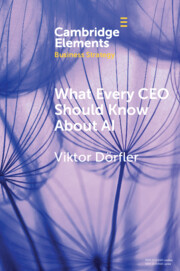Element contents
What Every CEO Should Know About AI
Published online by Cambridge University Press: 04 March 2022
Summary
Keywords
- Type
- Element
- Information
- Series: Elements in Business StrategyOnline ISBN: 9781009037853Publisher: Cambridge University PressPrint publication: 05 May 2022
References
- 11
- Cited by



